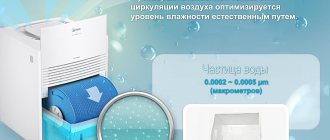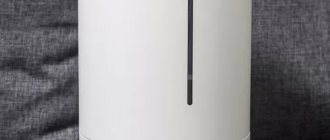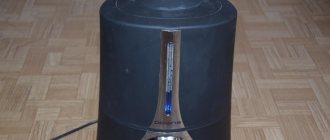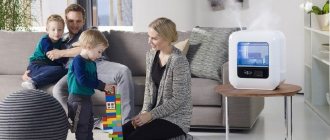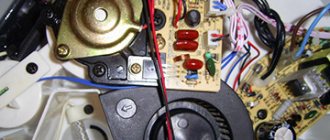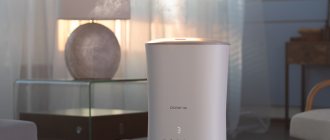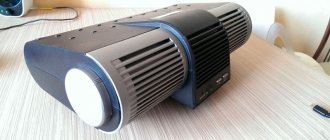What is an ionizer?
An air ionizer is a device that improves indoor air by enriching it with ions. Why is this necessary? The content of ions in enclosed spaces is negligible compared to the air in mountain and sea resorts. Air ionization allows you to correct this situation.
Let's give some terminology. An ion is an electrically charged particle. There are positively charged particles - cations, and negatively charged particles - anions.
Ionization is possible for both gas and liquid. The product of ionization of a liquid is water ions, and air ions are aeroions.
An aeroion is an atmospheric ion, that is, a negatively or positively charged air molecule. This term was introduced by the Soviet biophysicist A.L. Chizhevsky. He also called the process of air ionization aeroionization.
Ions and ionization
Ions are atmospheric particles that carry a negative or positive charge. Scientific research has proven that the absence or small amount of negatively charged ions (anions) in the air and at the same time the predominance of positively charged ones (cations) can negatively affect health, namely:
- Feels oxygen deprived
- Performance decreases
- Increased risk of cardiovascular disease
- Nervous disorders progress (irritability, depression, insomnia)
- Signs of immunodeficiency develop
- Allergy symptoms progress
Under natural conditions, the saturation of air with anions occurs naturally and is especially noticeable in coastal, mountainous and forest areas. That is why, when relaxing at the sea or in the mountains, we very quickly restore our strength and feel harmony and comfort. How easy it is to breathe after a thunderstorm! This is also due to negative ions.
The atmosphere of modern cities and homes is characterized by a large number of positively charged ions, as well as an extreme degree of pollution and dryness. The terrifying environmental reality makes the situation even worse. All these factors together literally undermine the health and psychological balance of modern man, and children are especially sensitive to this. Also, the predominance of cations is facilitated by a large number of working household appliances in the apartment (TVs, computers, etc.)
Correcting all these points was the task of the developers of a humidifier with an ionization function. And such devices are now available to everyone, it’s just wonderful. Moreover, the cost is quite acceptable.
And by choosing such a model, you can inhale air identical to mountain air while in your apartment.
How does an air ionizer work?
The principle of operation of the ionizer is to produce ions and release them into the surrounding space. The most common devices are corona discharge devices. The main elements of such devices are pointed electrodes to which high voltage is applied. The coronary charge arising at the tip of the electrodes promotes the formation of ions.
The air ionized in this way is distributed into the room by means of a blower. Blowers can be external or built-in.
Ionizers of various types operate on both alternating and direct current. In the latter case, electric current rectifiers are installed in the device.
Ionizers are also equipped with high voltage sources and protective devices (responsible for automatic shutdown).
Ionizers can be either separate or built into other devices (air conditioners, printers, copying equipment). In such devices they are responsible for reducing static electricity.
An atmospheric air ionizer should not be confused with an ozonizer. An ozonator is a device for producing ozone, while a room air ionizer is a device that transfers a particular charge to oxygen molecules.
Fighting static electricity
Static electricity is a charge generated by the friction of various surfaces. The magnitude of this charge, of course, is very small, and by itself it cannot cause harm.
But with prolonged contact with electrified objects, a person himself becomes a carrier of a static charge. It accumulates, and the more a person is “shocked” by surrounding objects, the greater the magnitude of this charge becomes. Then it begins to irritate the nerve endings of the skin, changes vascular tone, and can even cause changes in the central nervous system.
The result is irritability, insomnia, and increased fatigue. And this is not to mention the ubiquitous presence of synthetic materials in life: clothes made from them do not allow the body to breathe, “electric shock”, causing discomfort. And at night, bedding with synthetic filler electrifies the hair, worsening its health, irritating with its “sparkling” and sometimes even disrupting sleep.
The ionizer built into the humidifier has an antistatic effect on the environment and neutralizes positively charged particles. In addition to humidifiers, hair dryers, vacuum cleaners, even keyboards and laptops are equipped with built-in ionizers.
Benefits and harms
The positive effect of using an ionizer is mainly due to an increase in gas exchange in the human lungs. The beneficial effect is manifested in:
- strengthening the immune system;
- acceleration of metabolism;
- reducing the manifestations of allergic reactions (nasal congestion, sneezing);
- reducing the risk of ARVI and other airborne diseases;
- accelerated cell regeneration - small wounds heal faster when using the device;
- improving sleep quality;
- a general positive effect on the body (the functioning of the cardiovascular system improves, the condition of the skin and hair is normalized);
- neutralization of radiation from household appliances.
The ionizer will cause harm if used:
- in unventilated rooms - in the process of releasing ions, ozone can also be released, which in high concentrations has a detrimental effect on human health;
- violating operating rules (for example, failure to maintain the minimum distance from the device to a person);
- in very dusty rooms - ionization of polluted air is undesirable, because charged dust particles actively settle on all surfaces of the room, their concentration in the air space also increases;
- in case of individual intolerance to air ions;
- for cancer (due to accelerated metabolism, cancer cells can become more active);
- in case of respiratory disease in the acute stage;
- children under 1 year.
Device properties
- Humidifies the room air
- Eliminates static electricity
- Removes dirt, grime and smoke
- Removes dust and allergens from the atmosphere
- Saturates the air with negatively charged ions
Ionization causes bacteria, viruses, pollen, dust, and smoke to become negatively charged and begin to be attracted to positively charged objects. As a rule, these are walls, floor and ceiling. Accordingly, the air becomes cleaner, which makes breathing easier, minimizes allergic reactions and generally has a beneficial effect on health.
The downside to this process is that “magnetized” dirt particles settle on the walls of the apartment. Therefore, if you frequently use a humidifier with an ionization function, you need to do wet cleaning more often.
It is preferable to place the device, for example, between the TV and the viewing area, or near the computer. Thus, the effect of radiomagnetic radiation, which produces positively charged ions, will be eliminated.
While first of all observing the recommendations of the device operating manual, you should also focus on the following points:
- The ionization function must be turned on for 10 minutes, only then can you enter the room and stay there while the unit is operating, but no more than 20 minutes. Over time, the duration of work can be increased. But do not exceed what is specified in the operating instructions.
- Listen to your feelings and, if you experience an unreasonable headache, a feeling of nervousness and discomfort, stop using the ionizer for at least 1 day. You can resume by reducing the operating time and increasing the distance to the device.
- It should also be taken into account that when ionization is turned on and at the same time a patient with viral or cold respiratory diseases is in the room, the infection can quickly spread throughout the room and contribute to the infection of other family members. Therefore, it is advisable not to use it.
Which is better - an ionizer or a humidifier?
You need to figure out what a humidifier is for and what it is, and what types they come in.
A humidifier is a device that maintains normal humidity in a room. Dry air is hazardous to health. The skin, hair, and mucous membranes lose life-giving moisture, and it is more difficult for the body to resist bacteria and viruses floating in the atmosphere. In addition, skin diseases require longer treatment.
Humidifiers are:
- Traditional. The operating principle of such devices is based on natural evaporation: a fan forces air onto a filter (cartridge, disk) moistened with water. They humidify the surrounding space quite weakly, but they consume little electricity.
- Steam. Humidification of the air occurs through the evaporation of hot liquid. They perform their function well, but are quite energy-consuming;
- Ultrasonic. Ultrasound turns water into fine particles that are released into the room as a mist of steam. They humidify the air most effectively; the humidity level can be adjusted.
Let's summarize. The ionizer is responsible for saturating the space with negative ions, making the air “healthy”. Humidifier – for providing the necessary humidity conditions. These devices have completely different functions, and there is no point in choosing between them. To ensure an ideal microclimate, both gadgets are needed.
This problem can be solved by a device that combines both options - a humidifier with an ionization function. In addition, using one device is more convenient than controlling the on/off of two.
However, some experts do not recommend combining a humidifier with an ionizer - exposure to moisture causes corrosion of the electrodes and premature failure of the device. However, it is up to you to decide how much the convenience of “two-in-one” prevails over the possible reduction in the service life of the device.
Main selection criteria
For a small room, a low-power humidifier is sufficient.
When choosing a humidifier equipped with an ionization function, users often pay attention only to the technical characteristics and rating of the product. However, to purchase a good device, you need to take into account other parameters:
- Device power and room size. The larger the second parameter, the higher the first. The maximum number of ions produced by the device does not exceed 50 thousand.
- Lack of ozone production function.
- System type. It is better to use active devices equipped with a fan.
- Availability of additional functions (air disinfection).
A good humidifier has the necessary quality certificates and accompanying documents. It is prohibited to use them in a smoky or very dusty room. Before purchasing, the product is checked directly in the store.
A humidifier with an ionizer helps make the atmosphere in your home safe and comfortable. When purchasing a device, possible contraindications are taken into account. Knowing the characteristics of the equipment and its types, it is easier to make a choice.
How to choose a decent model?
All home appliances must accurately reflect the needs of the household. Otherwise, you risk getting a mountain of unnecessary and unused electrical appliances.
Characteristics
Among the main parameters for the effective operation of ionizers, the following can be noted:
- productivity - the concentration of produced ions per cubic unit of volume. The optimal range for prophylactic use is 10,000–20,000 ions/cm3, for therapeutic use – more than 50,000 ions/cm3;
- emitter voltage. Should be within 20-30 kV for constant ion production;
- duration of continuous operation. To saturate the entire room with air ions, the device must be operated for several hours;
- maximum permissible ionization area. The discrepancy between the passport specifications and the realities of a large space will lead to the uselessness of the device.
Types of devices
Here are the categories into which devices are classified.
- By purpose:
- household (for home, office, car, etc.);
industrial.
- According to the charge of the produced ions:
- unipolar - produce only anions;
bipolar - produce anions and cations.
- According to the principle of ion propagation:
- active (with built-in fan);
- passive (the device releases ions, but is not responsible for their delivery to the far corners of the room).
- According to the presence or absence of control over the production of ions:
- adjustable (have the function of changing the voltage on the electrodes);
- unregulated (the rate of formation of new ions is not controlled).
- By filter type (if available):
- reticulate. Designed for initial rough cleaning of wool, sand, etc.;
- carbonic. Eliminates unpleasant odors, but is not able to capture light compounds;
- HEPA filter. Well retains allergen and fine suspension, but requires periodic replacement;
- photocatalytic - the most effective and expensive type of filter; cleaning is carried out by exposure to ultraviolet radiation.
- By device type:
- ionizers made from natural salt. The design is a small incandescent lamp installed in a crystal made of natural salt. As salt heats up, it produces negatively charged ions. They have poor performance, low power, and operate on mains power. Presented in various designs: salt lamps, spherical and unprocessed salt stones;
- ionizer-purifier. These models have a filter for air purification;
- ionizer-humidifier. The air ionization function is built into the humidifier. Enabled by default or additionally by pressing a button;
- air washing. This is an ionizer, purifier and humidifier in one device. The air is usually purified through water filters - the slightest contaminants will not be able to enter your lungs.
For personal use, a device with a small service area is suitable, but large industrial premises require the use of a professional unit. These models will differ in productivity, power, volume of processed premises, as well as dimensions.
A bipolar air ionizer is better, since the SanPiNs in force in Russia establish the same content of positive and negative ions in the atmosphere of residential premises.
How to use?
There are several general rules to follow when using such a device:
- The ionizer cannot be turned on for the whole day or even for several hours. On all models, the instructions indicate the recommended operating time. As a rule, this takes no more than 3-5 minutes.
Be prepared for the fact that the first time after using the device you may experience dizziness or weakness. This is normal, remember that similar feelings arise during trips to nature.
- The device should be turned on if the room temperature is from 5 to 30 degrees, and the relative humidity is no more than 80% RH.
- The first time after turning on the ionizer, it is better to leave the room where it is working. This is due to the fact that during the first few minutes the device removes aerosol particles from the air, causing them to settle.
- In the room where the device operates, you will have to wash the floor more often, because the ionizer causes all volatile particles to settle down.
- There is no point in turning on the device during ventilation. Also, its operation is not a complete alternative to open windows. It is necessary to alternate both procedures.
- Smoking is strictly prohibited in the room where the ionizer is operating. Under such conditions, the harmful effects increase.
It is worth remembering that the efficiency of the ionizer largely depends on where you place it. As a rule, the optimal distance from the device to a person should be at least 1-3 meters. More accurate information can be obtained from the technical data sheet that comes with the device.
If you want the device to provide maximum protection from electromagnetic influences, then it must be placed between the emitting device (TV, computer, game console, etc.) and the user. Usually, various types of mounts are included with the ionizer itself, allowing you to place it almost anywhere - on the ceiling, wall, etc.
Maintenance of the device may also affect its effectiveness. The frequency of washing and cleaning depends on which filter is installed in a particular model:
- Electrostatic . It is necessary to rinse the filter under running water every 7-14 days and wipe it with a napkin or damp cloth.
- Nera filters . Requires cleaning every 30-60 days. Dust can be removed using an ordinary household vacuum cleaner.
If we talk about ionizer-humidifiers, they also require regular cleaning. Their design includes an evaporation filter, which is necessary to purify the steam. Various contaminants can settle on it, and scale can also form, so once every 7 days it needs to be washed in the shower.
Operating principle of ionizers
Based on the mechanism of air ion production, two groups of devices can be distinguished:
- for domestic purposes (electroeffluvial ionizer (Chizhevsky chandelier), corona discharge ionizer);
- for industrial purposes (plasma, thermal, hydroionizer, ionizer using radioactive and ultraviolet radiation).
The former are safe for humans: they do not emit ozone or harmful radioactive particles. The latter cannot boast of this, and therefore are used mainly for the production of construction and other materials (curing resins, etc.).
Forewarned is forearmed. You are now familiar with the selection criteria, and our list of various models will help you navigate the large assortment of products on the market.
Rating of air ionizers
Thanks to the arrangement of devices in order of increasing cost and set of options, choosing an air ionizer for your apartment among them will not be difficult for you.
Polaris PUH 7040Di
This is an ultrasonic air humidifier with a built-in ionizer. Cost from 2500 rubles. Dimensions (hereinafter WxDxH) 260x260x330 mm Power 25 W, 1 year warranty. Water tank capacity – 3.5 l. Serviced area 40 sq.m. Manufacturer – USA.
The device is equipped with a timer that allows you to set the operating time of the device (up to 12 hours). The electronic hygrometer will measure the humidity in the room and the display will show the low water level. Housewives will be pleased with the simple cleaning and reusable use of the ceramic filter - washing the device is no longer a hassle.
The device will not cause a fire due to automatic shutdown in the absence of water.
The possibility of using aromatic oils is a good reason to have a romantic dinner!
Night mode is especially important for good sleep - the electronic display is not so bright at night. Ideal for an apartment where there is a small child.
Equipped with modern touch controls. Installed on the floor.
Available in blue, green, lilac and pink colors.
AIC SPS-840
Cost from 3330 rubles, dimensions 340x190x260 mm. Power 38 W. The capacity of the water tank is 4 liters. Recommended for rooms up to 30 sq.m. Manufacturer – China.
In this ultrasonic humidifier, the ionization can be turned on and off as desired by the user.
Evenly distributes moisture with a double-sided sprayer.
The remote control will appeal to lazy people - you can control the device without getting up from the couch. Push-button control directly on the device is also possible.
A timer and automatic shutdown if there is insufficient water will ensure that the device is turned off in a timely manner.
The cute design of the gadget will allow it to fit seamlessly even into the work environment of a formal office - externally, the device looks like a small TV monitor.
Ecology-Plus Super-Plus-Turbo (2009)
A desktop air purifier, also known as an ionizer. Cost from 3380 thousand rubles, dimensions 275x145x195 mm. Power 10 W, 3 year warranty. Will cope with premises of 100 sq.m. Country of manufacture: Russia.
Room dust, allergens and other polluting particles are sucked into the device along with the air and settle inside the filter.
There is an indication of filter contamination, which will have to be cleaned manually. The good news is that you don't have to buy replacement filters.
Using the purifier, you can scent the air - aroma oil is even included in the kit.
The manufacturer guarantees cleaning efficiency of up to 96%, which is confirmed by tests of the device in domestic hospital wards. All information is available on the official website.
Air ionization in an apartment has never been so energy-saving - the power of the device is only 10 W! Simple push-button control will not take long to deal with the issues of operating the device.
Users note the rather primitive design of the device, but also the excellent performance of the promised functions, as well as silent operation.
Ballu AP-155
Ionic air purifier. Cost from 7750 rubles, dimensions 320x200x495 mm. Power 37 W, warranty 12 months. Serviced area 20 sq.m. Made in China.
Thanks to high-quality cleaning, even the smallest particles of pollen are removed. First, coarse dust settles on the pre-filter, then the HEPA filter traps fine contaminants, and finally, the carbon filter eliminates unpleasant odors. The three-step cleaning is excellent, making this purifier a godsend for allergy sufferers.
There is a timer and an indicator of the level of air purity. The ionization mode can be turned off if necessary.
Floor installation.
The modern, attractive design goes well with touch controls.
Advantages and disadvantages
Any apartment purifier protects the air from bacteria.
Advantages:
- safety for people suffering from allergies and asthma;
- works silently, will not disturb during rest and sleep;
- uses energy economically;
- eliminates unpleasant odors, actively fights bacteria and infections;
- brings the atmosphere closer to fresh and natural, saturates the body with oxygen.
Flaws:
- cannot be placed next to other electrical appliances due to exposure to a magnetic field;
- excess impurities in the air dries it out, so the humidifier must be turned off periodically;
- you need to clean the apartment more thoroughly: when the device operates with the cleaning function, dust particles scatter throughout the house and settle on surfaces;
- The humidifier and air ionizer require constant cleaning of its components.
